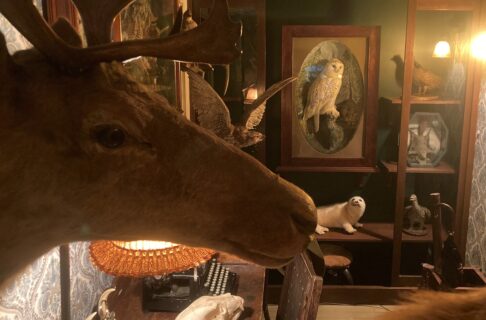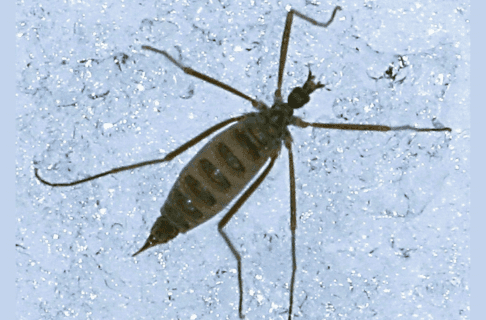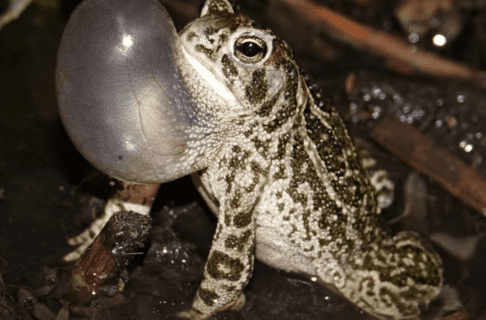Posted on: Thursday March 14, 2013
[Note: This blog contains descriptions and images that may not be suitable for sensitive individuals.]
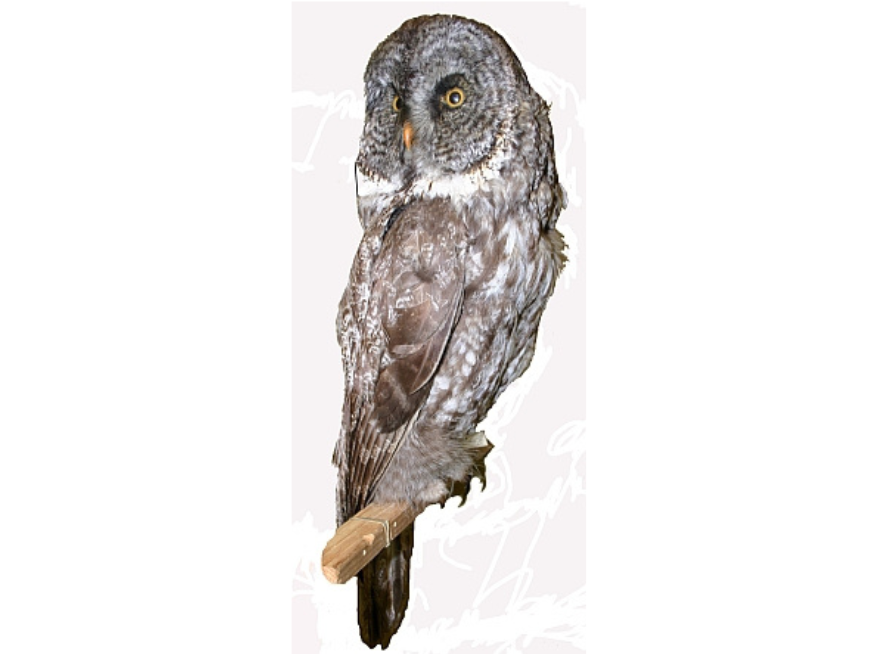
When thinking of Manitoba’s owls, the great gray (our provincial bird) is usually the first to come to mind, whereas of the 12 species recorded for the province, the barn owl (Tyto alba) would likely be the last. Although barn owls have one of the widest ranges of any owl species, occurring in temperate and tropical regions around the world, they are very rare anywhere in Canada, and especially so on the prairies. They just don’t do very well in our climate; -35°C is hardly tropical or even temperate! There are only about a dozen records for barn owl in Manitoba since the first was found in November of 1912, and several of these are sight records only – they are convincing, but remain unconfirmed by photos or specimen evidence. There is one recorded (failed) nesting attempt in 1994 in Springstein, about 20km west of Winnipeg, and this is the last confirmed sighting. [See the excellent species account in The Birds of Manitoba available from Nature Manitoba (www.naturemanitoba.ca ).]
Image: Not a barn owl, but a great gray owl, Manitoba’s provincial bird. This is a mounted Museum specimen (MM 3.6-901) from southern Manitoba collected in February 1917.
So imagine my surprise in mid-December when a report of an expired (and frozen) barn owl from a farm near Elie, Manitoba arrived in my e-mail inbox from Manitobabirds (a birding listserve)! The importance of the find was not lost on its discoverer, Mr. Dick Steppler, so he collected the bird and brought it to Jim Duncan of Manitoba Conservation. Jim has been banding and studying various owl species, particularly great gray and hawk owls for, well, probably longer than he’d care to admit, and has published several books and lectured extensively on these species. So Jim was the logical choice to notify about the barn owl, and, fortunately for the Museum, he has always been a great supporter of our collections, recognizing their value as both a repository and as a research tool. Our bird collection would soon contain Manitoba’s first record of barn owl for this century and the first in over 18 years!
But before it came to the Museum, it was off to Dr. Terry Galloway of the Entomology Department of the University of Manitoba. Among his many areas of expertise, Terry is an authority on external bird parasites, and because finding barn owls is so unusual, it was important to try to get as much information as possible from the specimen. Despite his careful inspection, this owl seemed free of external parasites.
I went to pick up the bird from his office and brought it back to the Museum. Under my and (mostly) Janis Klapecki’s guidance (our Collections Specialist), the bird would be prepared as a study skin by Laurel McDonald. Laurel is a wonderfully skilled volunteer who has been processing bird specimens for us over the last few years. Preparing a study skin is different from taxidermy, although it uses some of the same techniques; it is the finished product that is different. With the number of bird specimens we hold (over 6300), it would be far too time consuming and take too much storage space to create taxidermy mounts for each one.
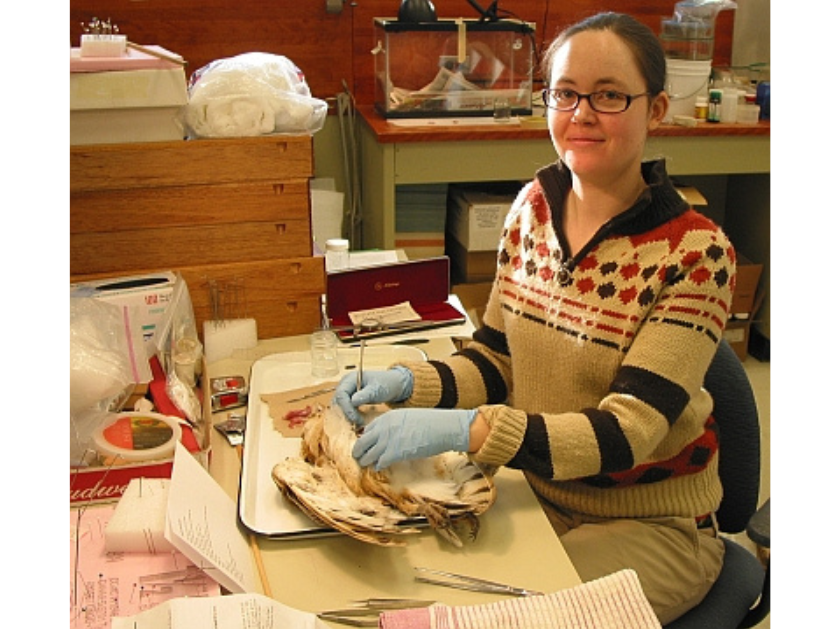
Volunteer bird preparator extraordinaire, Laurel McDonald, beginning to dissect the Elie barn owl to make a study skin.
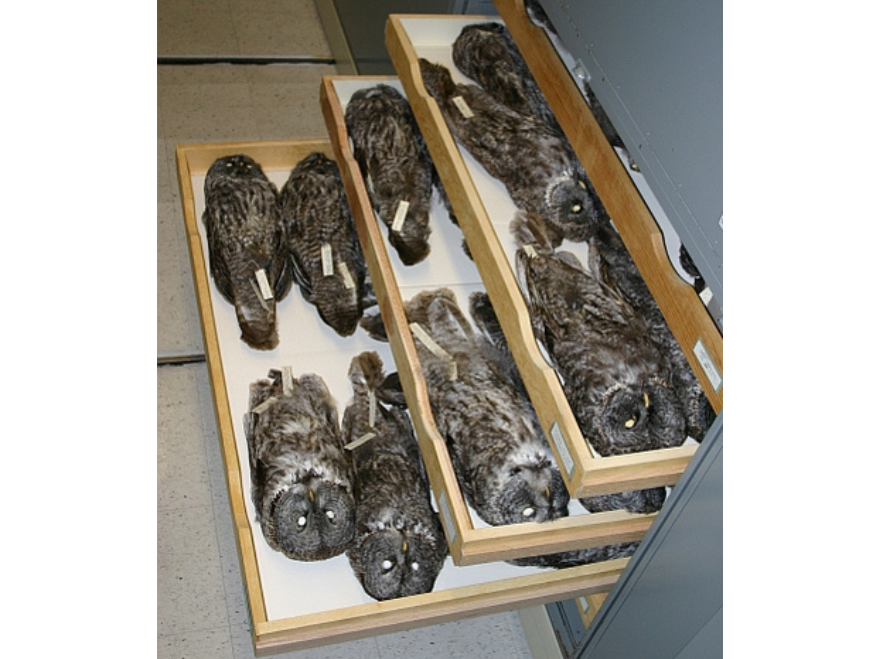
A cabinet of great gray owl specimens (Strix nebulosa). These are study skins arranged on their backs. Note that if these were all taxidermied mounts, they would require six or seven cabinets rather than one. Taxidermy is also a much more time-consuming and expensive process.
The barn owl was found frozen, but had been thawed a couple of times, once by Mr. Steppler to clean and reposition the bird, and another time by Terry in order to wash it for external parasites. Because there was no certainty as to when the owl had expired, we had no idea of what condition it would be in or whether it could even be made into specimen. If it had been outside a long time, it could either have decomposed substantially or it might have “freeze-dried.” In either case, there would be little we could do but make a skeleton.
To our surprise, the owl was in quite good condition (for a dead bird!), meaning it probably had not been long on the ground before it was found, but just long enough to freeze. To make the study skin, the bird is thawed, an incision is made along the belly, and the skin is peeled back from the body and over the head to be turned inside out. The body, including skeleton is removed with only the lower leg bones, some wing bones and the skull remaining with the skin. The skin is then turned right-side-out, stuffed with cotton and stiffened with a wooden rod to be arranged to lie flat on its back. The vital organs are examined for internal parasites (we found none), checked for general condition, stomach contents examined (although this specimen had none), and the sex organs are checked to determine gender and measured to assess condition. We saved some tissue for future DNA work, in case that is required, and the bones not left with the skin will be cleaned by dissection and in the “bug tank”, a special sealed treatment area that houses beetle larvae that will eat the flesh off the bones to make a clean skeleton.
Barn owls, like many birds, are difficult to sex externally with any confidence. Because this bird was quite buffy with relatively large spots on its breast, we were pretty sure it was a female, but couldn’t be positive. In most birds of prey the females are larger than males. In barn owls, females are bigger on average, but there is considerable overlap in measurements between the sexes. Dissection conclusively determined that this owl was a female. Plumage also suggested that it was a hatch year bird, meaning that it was under one year of age when it died. Although the bird was very emaciated (it had no fat at all), it seemed otherwise in pretty good shape and likely died of starvation. There was some indication of trauma and bruising on the lower right leg, but the bone didn’t appear to be broken, so it didn’t seem enough to explain its death. There were two holes in the skin of the right wing that we initially thought might be due to decomposition after death, but because the rest of the bird seemed in good shape, these might have been indicative of injury – although there was no evidence of bleeding so these are likely to be postmortem. The exact cause of death will remain unknown.
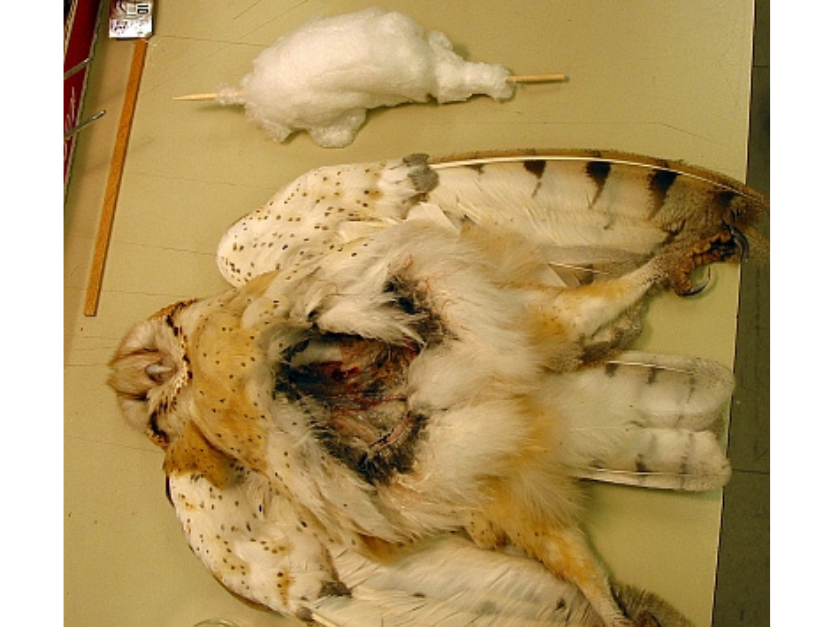
The Elie barn owl emptied of internal organs and most of the skeleton including the backbone. It has been turned right-side out and is ready for insertion of a cotton wad around a stick (top of photo) to give the study skin some shape and stiffness.
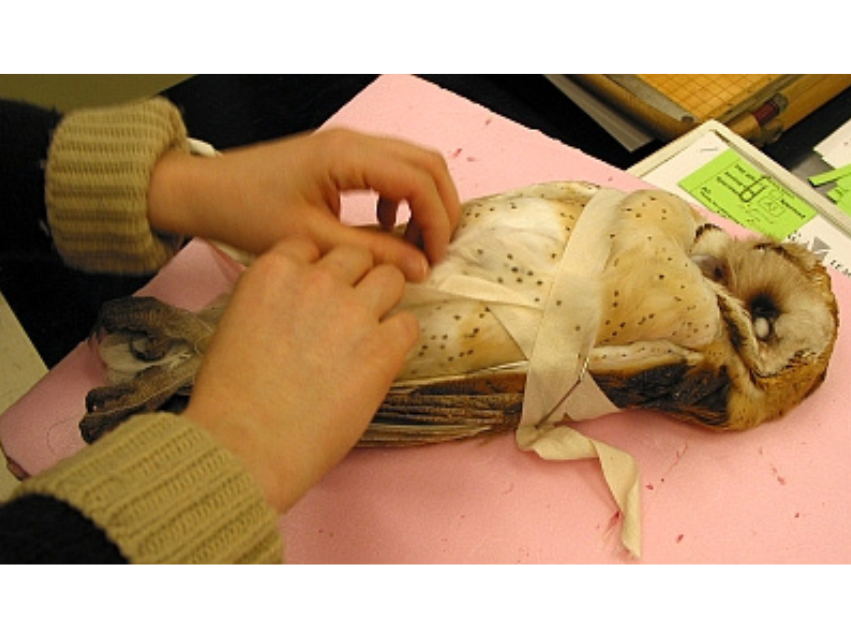
The study skin has been sewn up and is being wrapped for final drying before being placed with the main collection.
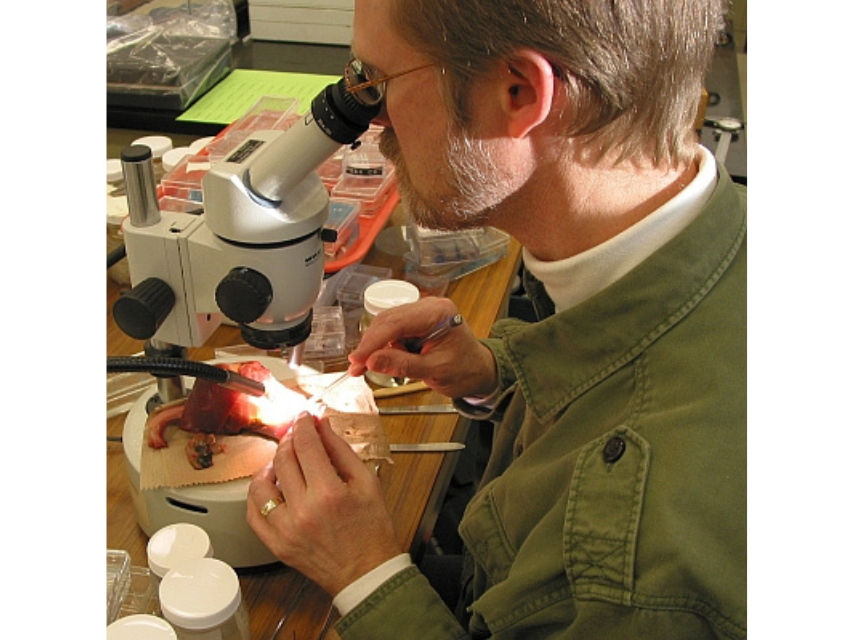
Examining the internal organs of the Elie barn owl to check for parasites, general condition, and clues to explain its demise. This is also the only way to definitively determine its gender; it was a female.
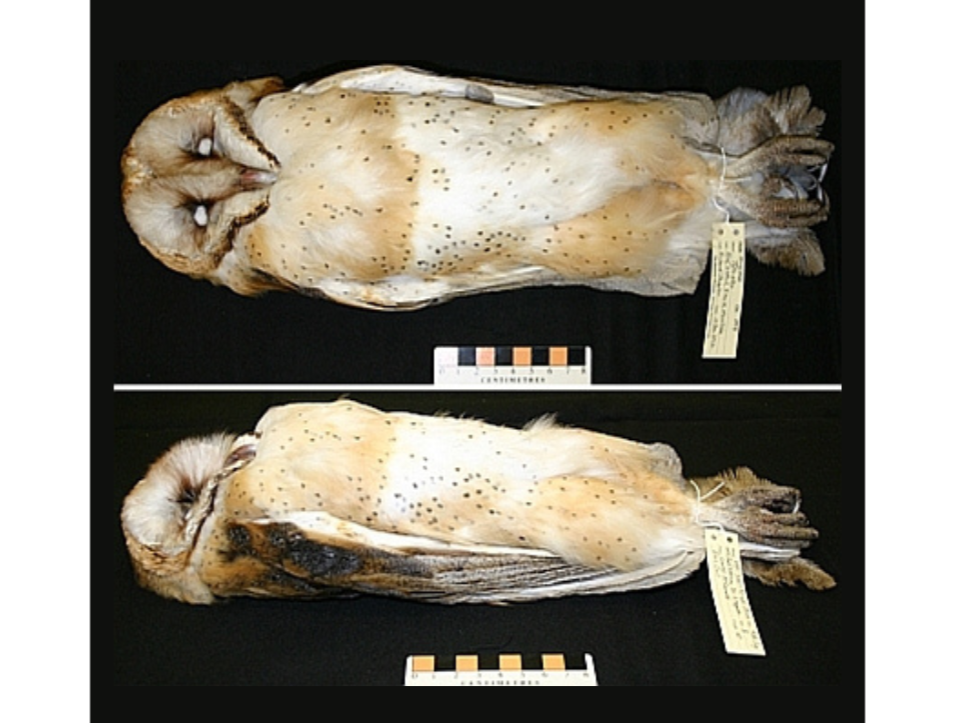
It is certainly unfortunate that the first confirmed record of barn owl for Manitoba this century was an expired individual. But with the specimen now in The Manitoba Museum collection, it provides a permanent record of its occurrence and it is available for study by the likes of Jim Duncan or other owl specialists. Given the unlikely possibility of finding this specimen before it was carried off by a coyote or became buried or otherwise dispersed, one wonders how many other records of rare species like the barn owl are missed. Even specimens of common birds are extremely valuable for the Museum collection. In many ways, common birds can tell us more about our environment because we have the “luxury” of statistical power – one specimen is a curiosity or even anomaly, but several specimens can provide a pattern and tell a coherent story. And bird collecting, in the historical sense, just doesn’t happen anymore (probably for the good!), so the Museum collections grow slowly. But the addition of the rare finds like the Elie barn owl, along with window-killed specimens of common species make valuable contributions to our understanding of Manitoba’s birds.
Image: “Top” and side view of the finished study skin of the Elie barn owl (Tyto alba) (MM 1.2-5418). Note the buffy breast and relatively large spots that hinted that this was a female. Dissection confirmed the gender. Scale bars are in centimeters.
Stay on the lookout for the unusual any time you are outside. You never know what exciting contributions you might make to our province’s natural history. A special thanks to the sharp-eyed Elie resident, Dick Steppler, who recognized the value of his discovery. Generations of researchers can now benefit from his thoughtful addition to the Museum collections.




